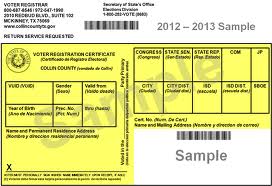Wayne Slater has a contrarian perspective on the voter registration numbers.
Still the only voter ID anyone should need
Getting new voters begins with registering new people. When the secretary of state last week announced a record-high 14 million Texans are registered to vote, Battleground Texas trumpeted that number as evidence their efforts are working. Not so much, it turns out, according to the actual numbers.
For example, voter-registration in the top five Democratic-rich South Texas counties where Davis expects to do well is up 5.8 percent from the last time there was a governor’s race – slightly better than the average statewide. But voter registration in five top GOP-rich suburban counties is up a whopping 13.8 percent.
The Davis camp hopes for a good showing in Dallas County and Harris County, especially among Democratic-leaning black and Hispanic voters. Dallas County voter registration is up about 5 percent from four years ago. Harris County is up over 6 percent. And voter registration in Travis County where Battleground Texas has a strong presence is up 8.4 percent.
But the real voter-registration increases this election are in suburban GOP strongholds like Fort Bend County (17.5 percent), Collin County (14.3 percent), Rockwall County (12.9 percent), Denton County (11.6 percent) and Williamson County (14.2 percent).
Does that mean Battleground Texas has failed to deliver on its much-ballyhooed promise to register new voters? Not necessarily. In the big South Texas counties they say they’ve targeted, the increase in registered voters is a lot better this year than four years earlier. For example, in Hidalgo County, voter registration is up 7.5 percent from 2010. Four years earlier, when Democrat Bill White was on the ballot, voter registration grew 5.9 percent in from 2006 to 2010. The same thing for Cameron County, where voter registration this time has grown twice as much as it did between 2006 and 2010, the last governor’s race.
Three things here:
1. Comparing percentage increases can be misleading, because things that are smaller to begin with can have sizable percentage increases without actually increasing all that much. Rockwall County, for example has 51,787 registered voters in it. That’s an increase of 5,944 over their 2010 number of 45,843. That doesn’t crack the top 20 total increases as I noted in my previous post, and the total number of registered voters in Rockwall County is less than the increase in registered voters in Dallas County, which grew by 58,086.
2. We can argue over the numbers all we want, or at least until we start seeing some data about who actually voted, but who was registered matters at least as much as how many of them were. As I’ve said before, some of the increase in voter registration is the natural result of population growth. We know that Battleground Texas has focused a lot of resources on voter registration. One presumes they’re smart enough to target people that will be likely to go Democratic if they vote. There may have been some concerted Republican effort to register like-minded voters – I don’t know, and the story Slater links to doesn’t address the question – but again, one would think that if there were something comparable on the GOP side it might have warranted some attention from the press. Be that as it may, we don’t have to guess, or at least we don’t have to guess blindly on insufficient data. The various county clerks and elections administrators could provide, if asked by a professional reporter, more detailed information about where those new voters came from – what precincts, for example, whose more fine-grained electoral information might provide a richer illustration – and about their racial and ethnic composition. We don’t have enough information here to base a judgment on this, but that doesn’t mean that information doesn’t exist. It’s there if a professional political reporter wants to find out about it.
3. All that said, the burden of proof remains with BGTX. They are trying to do something that hasn’t been done before, and some level of skepticism is warranted until we see evidence of success in the results. A lot of those heavily GOP counties Slater cites have been slowly trending Democratic in Presidential years, but outside of Fort Bend the increase in Democratic votes from 2006 to 2010 failed to keep up with the growth in registered voters. That’s the challenge, and that’s what it will take to move the needle in the GOP strongholds. The good news is that we should have some idea of how this is going as soon as we have data about who is voting early. Whether the good news continues from there, that’s the question.


Another potential positive for BGTX and democrats overall. Assuming a majority (for now) of the registered voter increases in the suburban counties is R, a fair number of those would be those who fled the more urban counties – in other words, shifting the R’s to the burbs. Thus, the increase in registrations in the urban counties is that much more dramatic (and likely democratic).
Fort Bend County’s population growth is booming but it is not necessarily conservative growth. The county will be a purple county before you know it…